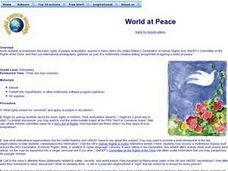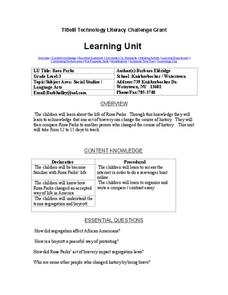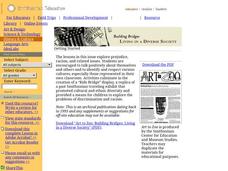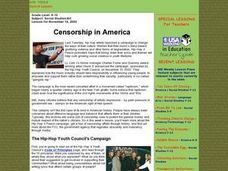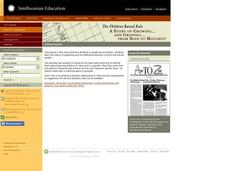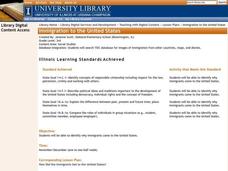Maryland Department of Education
Our Children Can Soar
Amazing efforts of African American leaders are celebrated in a lesson on civil participation. The engaging resource focuses on primary and secondary sources to analyze the impact of African American leaders such as Ella Fitzgerald....
Curated OER
Word Art with King's Words
Learners investigate equality and racism by creating a word art project. In this civil rights lesson, students discover the life of Martin Luther King Jr. and create a word art project using the Internet site Wordle Web. ...
Curated OER
What is Suffrage? Understanding the Right to Vote
Learners discover one of the restrictions forced on women of the early 1900s. In this civil rights instructional activity, students investigate suffrage and why women were not allowed to vote in the early twentieth century. Learners...
Curated OER
World at Peace
Students explore world peace by creating a PowerPoint presentation. In this human rights lesson, students discuss the current conditions of human rights around the planet and view an on-line exhibit hosted by UNICEF. Students discuss...
Library Sparks
When Marian Sang: Reader's Theater
Put on an eight-actor show based on Pan Munoz Ryan's When Marian Sang: The True Recital of Marian Anderson. The resource comes with a color-coded script that includes some images from the picture book.
Curated OER
Jazz Music and the Crisis Over School Desegregation
High schoolers will learn to appreciate the civil rights movement with a focus on Little Rock, Arkansas. They will also acknowledge Louis Armstrong's unparalleled contributions to American music.
Curated OER
The Little Rock Nine
Students research the integration of Arkansas' Central High School. They role-play as students integrating the school and describe their experiences.
Curated OER
Where are the Famous Women in History?
Students investigate sexism in history by identifying important women from the U.S. In this women's equality lesson, students discuss why they remember more men in the history of the U.S. than women. Students compare women's...
Curated OER
Parenting in the Movies:Examining Responsibilities in Modern American Films
Students use films to identify the characteristics of a good parent. In groups, they research the different types of parenting methods used during colonial times, the Civil War and the Civil Rights movement. As a class, they develop...
Curated OER
The Segregated Pencil Sharpeners
Students explore racism through pencil sharpeners. In this civil rights lesson, students utilize a pencil sharpener with one of two colored pencils and explain how some people were not allowed to use certain items because of the...
Curated OER
Letters from the Japanese American Internment
Students examine letters of Japanese-American children during internment in World War II. They discover what it was like in the camps and how they were treated once they were released. They also view photographs of the camps.
Curated OER
Rosa Parks
Students complete a variety of written and discussion activities regarding Rosa Parks and the Alabama bus boycott and how they changed an accepted way of life in America.
Curated OER
1960's Protest Songs
By learning about 1960's protest songs, and the politics of the era, students can broaden their understanding of music and history.
Curated OER
Building Bridges: Living in a Diverse Society
Students participate in various activities that help them build esteem, and explore racism. In this multicultural lesson plan, Students increase their awareness of, and appreciation for, cultural differences and similarities. This...
Curated OER
Censorship in America
Students follow resource links to study the history of art censorship in the US. They study the work of the FCC and the Hip-Hop 4 Peace campaign.
Curated OER
Baga Drum
Students examine a Baga Drum in order to explore the history of the Baga people of West Africa. In this art history lesson, students recognize figures used in Baga Drum design that represent aspects of Baga culture. They also design and...
Curated OER
Immigration to the United States
Third graders search TDC database for images of immigration from other countries, maps, and diaries. They identify why immigrants came to the United States and engage in a role-play simulating an experience the immigrants might have had.



